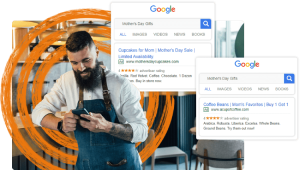How You Can Maximise Traffic During Peak Shopping Times with eCommerce SEO Services
As a business owner, you understand how crucial peak shopping periods are for your bottom line. Whether it’s the End of Financial Year (EOFY) sales or the festive holiday season, these times present a massive opportunity for boosting your sales. But with increased competition, how can your store stand out and attract a larger audience? The answer lies in leveraging eCommerce SEO services.
In this blog, we’ll walk you through concrete strategies you can implement to optimise your store’s SEO, helping you drive traffic during these critical shopping times. From keyword research to page speed, here’s how to maximise your store’s visibility and turn peak periods into profitable seasons.
Utilizing eCommerce SEO to Capture Peak Shopping Traffic
Peak shopping periods, such as Boxing Day and EOFY sales drive consumer spending to new heights. People are always on the hunt for the best deals, and if your online store isn’t optimised for search engines, you’re likely missing out on a large chunk of potential customers.
By implementing the right eCommerce SEO strategies, you can ensure that your products appear at the top of search results when buyers are most motivated to purchase. With millions of people searching for deals during these times, it’s essential that your eCommerce store is easy to find.
1. Start with comprehensive keyword research
To increase your store’s visibility during peak shopping times, keyword research is the foundation. Begin by identifying keywords relevant to your products and shopping periods such as “EOFY sales” or “Christmas gifts”. You’ll also want to include long-tail keywords like “best deals on women’s clothing EOFY” to capture niche audiences.
But don’t stop there. Use eCommerce SEO services to track which keywords your competitors are ranking for and identify gaps in your strategy. Tools like Google Keyword Planner, SEMrush, and Ahrefs can provide valuable insights into search trends during these periods.
For example, if you’re selling electronics, phrases like “EOFY deals on smartphones” can bring in a specific, high-intent audience.
2. Optimise product pages for peak periods
Your product pages are the backbone of your store, so making sure they are fully optimised for search engines is vital. Here’s how:
- Title tags and meta descriptions: Include shopping-specific keywords like “EOFY discounts” or “holiday sales” in your title tags and meta descriptions to grab attention and improve click-through rates.
- Headings: Use H1 and H2 tags effectively, inserting your target keywords naturally. For instance, a header like “Shop the Best EOFY Electronics Deals” not only improves SEO but also aligns with customer intent.
- Product descriptions: Craft detailed, keyword-rich descriptions for your products. Avoid generic descriptions that can be found on other websites. Tailor each product’s copy to reflect its unique features while incorporating peak shopping terms like “EOFY savings” or “Boxing Day bargains”.
By optimising your product pages, you’ll rank higher during these high-traffic periods, and buyers will be more likely to click on your listings over your competitors.
3. Leverage seasonal content marketing
A content marketing strategy aligned with peak shopping times can work wonders for your eCommerce store. Not only does it help you rank for specific shopping terms, but it also establishes you as a trusted source of information.
- Create gift guides: A blog titled “Top 10 Christmas Gifts for Tech Lovers” is a great way to bring in traffic during the holiday season. Use internal linking to direct readers to your relevant product pages, improving both SEO and sales conversions.
- Run sales blog posts: Writing about your up on coming sales a month or two in advance gives you the opportunity to rank for those terms before the competition catches up. Optimise these blog posts with keywords like “EOFY deals” and “Christmas sales” to bring traffic to your store.
- Promote holiday deals on social media and newsletters: Sharing your optimised blog content on platforms like Facebook and Instagram, or via email marketing, amplifies your reach and keeps potential customers informed about your deals.
Not only will this boost your SEO rankings, but it will also engage your audience in a meaningful way, keeping your brand top of mind when they’re ready to make a purchase.
4. Improve site speed and mobile usability
During peak shopping periods, customers expect fast, seamless shopping experiences. If your site is slow or not mobile-friendly, you’re likely to lose potential customers to faster, better-optimised competitors.
Here’s how to address this:
- Page speed optimisation: Tools like Google PageSpeed Insights can help identify issues slowing down your website. Compressing images, minimising HTTP requests, and using a reliable hosting service are just a few ways to improve load times.
- Mobile optimisation: With the majority of people shopping via mobile devices, your eCommerce site must be mobile-responsive. This means ensuring that images, text, and checkout processes are smooth and easy to navigate on smartphones and tablets.
Fast-loading pages and a responsive design can also improve your SEO rankings, as search engines prioritise websites that offer great user experiences.
5. Run A/B testing on key pages
Test different layouts, headlines, and call-to-action buttons on your product and landing pages to see what converts best during peak times. Use insights from these tests to refine your pages, ensuring they are as effective as possible in capturing customer attention and driving sales.
6. Focus on Local SEO
If your eCommerce store caters to specific customers, optimising for local SEO is important, especially during peak shopping times. Here’s how to make sure local buyers find your store:
- Use location-based keywords: Include phrases like “EOFY sales Australia” or “Christmas gifts Sydney” in your content. This helps your store appear in local search results, especially when everyone is looking for specific deals near them.
- Google My Business: If you also operate physical stores, updating your Google My Business listing with peak shopping hours, current sales, and any click-and-collect options can drive more foot traffic and online purchases.
- Local backlinks: Partner with local bloggers or influencers to generate backlinks to your store. This not only builds your brand’s authority but also improves your SEO rankings.
By investing in local SEO, you increase the chances of capturing highly targeted traffic, ready to buy during peak shopping periods.
7. Utilize countdown timers and urgency cues
Implement countdown timers on your product pages for limited-time offers. This not only creates a sense of urgency but also encourages immediate action from shoppers. Pair this with relevant keywords like “limited time EOFY deals” in your meta descriptions and headings to improve visibility in search results, tapping into customers’ desire to snag deals before they expire.
8. Use structured data to highlight your deals
Structured data, also known as schema markup, helps search engines understand the content of your website. It’s especially useful during shopping periods as it allows you to display rich snippets like product ratings, prices, and stock availability directly in search results.
For instance, adding structured data to your product pages can show buyers that your product is in stock and on sale, driving more clicks and conversions. This type of optimisation can give your eCommerce store a significant advantage over competitors who aren’t using schema markup.
9. Create FAQ sections
Implement a frequently asked questions (FAQ) section on your product and category pages. Address common questions related to your peak shopping events like shipping times or return policies. This not only improves user experience but also provides additional opportunities to incorporate relevant keywords. Structured data can be used here as well to enhance your chances of appearing in rich snippets, further boosting visibility.
10. Update internal links and site navigation
During peak shopping times, buyers expect to find what they need quickly. This is where optimising your site’s navigation comes into play. Make sure your internal links direct customers to seasonal sales pages, featured products, and popular categories.
For instance, during the EOFY sales, add a prominent link to your EOFY sale page on your homepage. Use internal linking to guide users through your sales funnels, from blog posts to product pages, and from product pages to the checkout.
By making it easier for buyers to find your deals, you increase the likelihood of them making a purchase.
11. Track and Analyse Your SEO Efforts
Finally, it’s imperative that you track the performance of your eCommerce SEO services during peak shopping periods. Set up tools like Google Analytics and Google Search Console to monitor key metrics such as organic traffic growth, keyword rankings, conversion rates, and bounce rates
By analysing this data, you can make informed adjustments to your SEO strategy, ensuring that your store continues to perform well throughout the peak shopping season and beyond.
Maximise Your Store’s Traffic with eCommerce SEO Services
Peak shopping periods like EOFY and the holiday season offer immense opportunities for online stores to attract more traffic and increase sales. By implementing the tips above, from optimising your product pages to improving site speed, you’ll set your store up for success during these times.
If you’re ready to take your store to the next level, let the experts at Digital Animals help you with personalized eCommerce SEO services. We’ll ensure your store is fully optimised to rank higher, attract more traffic, and convert more customers.
Talk to us today to learn how we can assist with your digital marketing needs, and let’s make your next peak shopping period the most profitable yet!







